
Intro
When considering a new running shoe, there are so many similar-looking shoes on the market being made by so many different companies, it is virtually impossible to (1) know where to begin; (2) quickly figure out which one or two products from a given brand might work well for you; and (3) determine what products from other brands might be the most similar and also worth considering.
So in our new “Blister Brand Guide” series, we provide an overview of the entire product lineup of a brand; highlight how each product stands out from the rest of that brand’s lineup; and help you figure out quickly and easily which shoe might work best for you.
In our individual product reviews, we go very deep into the details of particular products. With these Brand Guides, the goal is not Depth, but Breadth. Our Brand Guides and full reviews are designed to complement each other — provide a broad overview of entire company lineups, and then also very detailed reviews of individual products.
Salomon: Brand Background
Since its beginning in the High Alps in 1947, Salomon has become one of the largest running shoe brands, particularly in the trail market.
Salomon’s shoes tend to run on the narrower end of the spectrum and offer more minimal cushioning, though they’ve diversified their line in recent years.
Salomon’s “high cushion” shoes are still much more minimal compared to the “high cushion” shoes from brands like Hoka and Altra. Salomon’s shoes generally provide a firmer ride and plenty of ground feel. While many individuals with wider feet struggle to find Salomon shoes that feel roomy enough in the midfoot, Salomon does have a few models that come in a “wide” version. Their shoes tend to have a higher heel-to-toe drop (typically in the 6-10 mm range) compared to many of their competitors’ shoes, so if you prefer a lower-drop shoe and / or tend to strike with your forefoot, this is important to keep in mind.
Salomon’s “S/Lab” shoes are designed for racing. They are the lightest shoes Salomon makes and tend to wear far faster than their other models. The S/Lab models also tend to have a lower drop than many of the other shoes Salomon makes. The S/Lab models often mirror another shoe in Salomon’s lineup, which we’ll mention in the brief summary of each shoe.
Most of Salomon’s trail shoes have a “quick lacing” system, designed with a “buckle” that slides down the laces to your desired tightness, rather than having to tie traditional laces. The buckle and excess lace then tuck into a pocket on the top of the tongue in each quick-lace shoe. All of Salomon’s current road shoes use a regular lacing system, while the vast majority of their trail shoes use quick laces.
Salomon also makes waterproof versions of many of their popular models, whether that’s with a Gore-Tex insert or Salomon’s proprietary ClimaSalomon waterproof insert. The waterproof versions will feel extremely similar to the non-waterproof versions in terms of support, cushioning, and midsole feel, but obviously provide better weather protection and they also tend to be significantly less breathable.
Finally, Salomon uses their own “Contagrip” rubber compound for their shoes’ outsoles, and offer it in three main variations. Contagrip TA is the stickiest and least durable, Contagrip MD is the least sticky and most durable, and Contagrip MA falls in the middle.
ROAD SHOES
(Most Cushioned to Least Cushioned)
Most Cushion
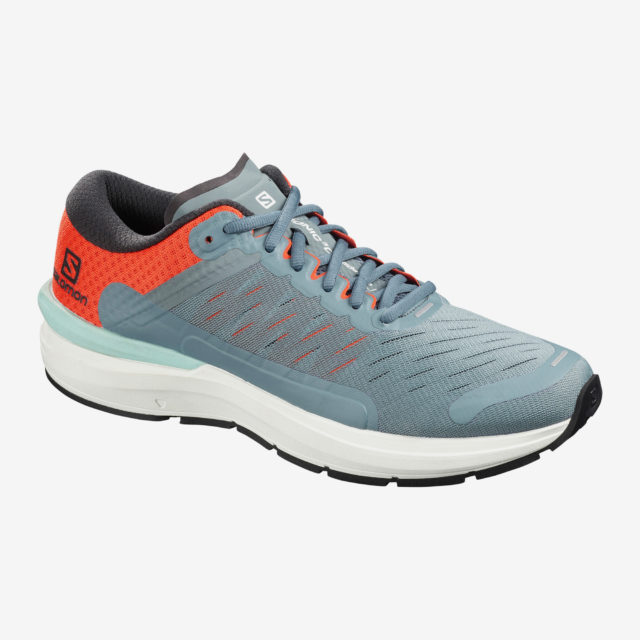
The Sonic line is still Salomon’s main series of road shoes for 2020, but each shoe has gotten a new name and a few updates. The Sonic 3 Confidence replaces the Sonic RA Max 2 as the brand’s most cushioned road shoe. It’s also got a new “Optivibe” insert in the heel, which supposedly reduces vibrations to limit muscle fatigue. While it probably won’t feel as plush as a truly maximal road shoe like the Hoka Bondi 6, the Sonic 3 Confidence will probably be your best bet if you’re looking for a well cushioned Salomon road shoe for longer pavement miles.
Stack Height
- Heel: 31 mm
- Toe: 21 mm
Drop: 10 mm
Stated Weight
- Men's: 268 g
- Women's: 225 g
MSRP: $130.00
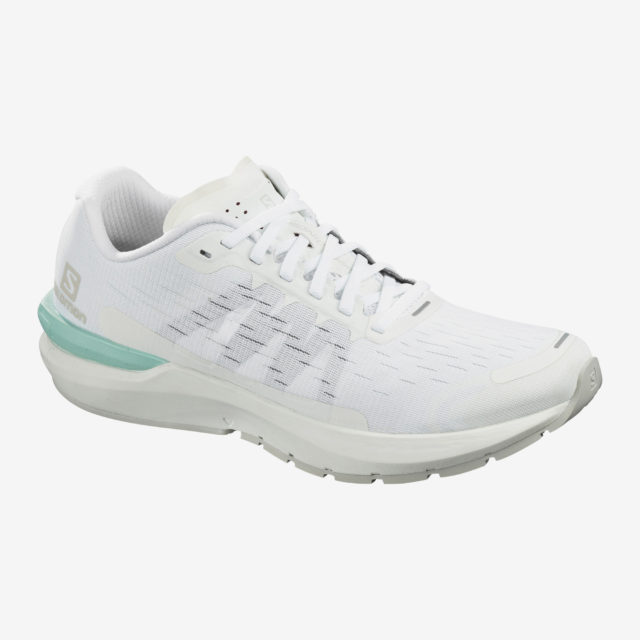
The next step down in the Sonic series, the Sonic 3 Balance, has a slightly lower stack height and drop than the Sonic 3 Confidence. It replaces the Sonic RA 2 from last year. Aside from its lower stack height, the Sonic 3 Balance has the same midsole cushioning (complete with Optivibe insert), outsole pattern, and upper as the Sonic 3 Confidence. As its name suggests, the Sonic 3 Balance aims to provide a balance of cushion and efficiency that should make it a solid option for most everyday training runs.
Stack Height
- Heel: 28 mm
- Toe: 20 mm
Drop: 8 mm
Stated Weight
- Men's: 252 g
- Women's: 216 g
MSRP: $130.00
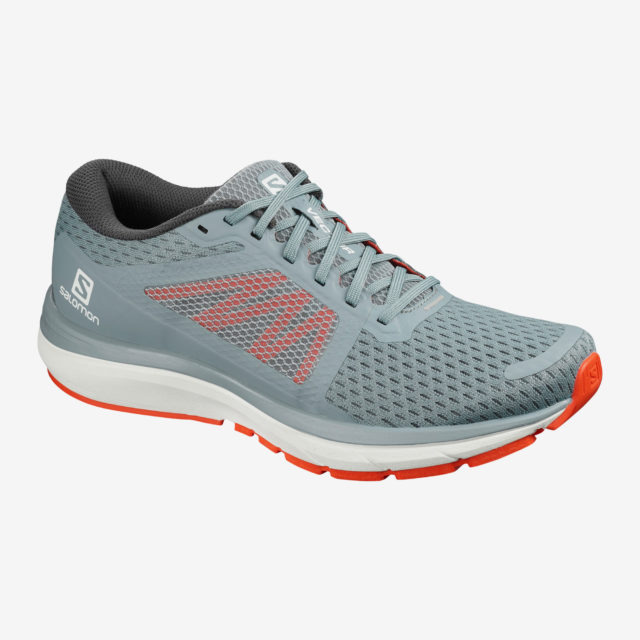
The Vectur is Salomon’s new everyday training shoe for 2020. It’s got a more standard EnergyCell+ midsole without the Optivibe insert found in the Sonic series shoes, with the EnergyCell+ midsole being designed to provide a fairly firm, fast ride. While it’s got the same heel-to-toe offset and stack height as the Sonic 3 Balance, the Vectur is a bit lighter and likely a bit firmer. It’s not quite as light as the Sonic 3 Accelerate, but it should still be a solid option for all-round training use, including “average-paced” runs and faster workouts. Its slightly lower price might also make it more appealing for day-to-day use than the shoes in the Sonic line.
Stack Height
- Heel: 28 mm
- Toe: 20 mm
Drop: 8 mm
Stated Weight
- Men's: 237 g
- Women's: 199 g
MSRP: $110.00
Salomon Predict Soc
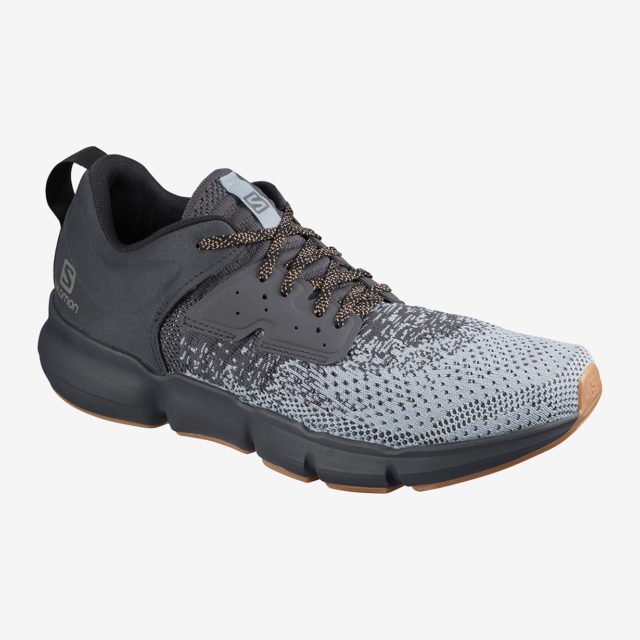
The Predict Soc is designed to provide maximum comfort for both running and every-day use. It’s got a soft, knit upper that’s designed to provide a sock-like fit and gives the shoe a more casual look than Salomon’s other road offerings. The Predict Soc also has the same “anatomically decoupled midsole” found on last year’s Predict RA, which is designed to provide a smoother, more flexible ride than Salomon’s other road shoes with traditional midsoles. If you’re looking for a flexible, comfortable road shoe that can double as a casual street shoe, the Predict Soc could be a good option.
Stack Height
- Heel: 28 mm
- Toe: 20 mm
Drop: 8 mm
Stated Weight
- Men's: 258 g
- Women's: 235 g
MSRP: $130.00
Least Cushion
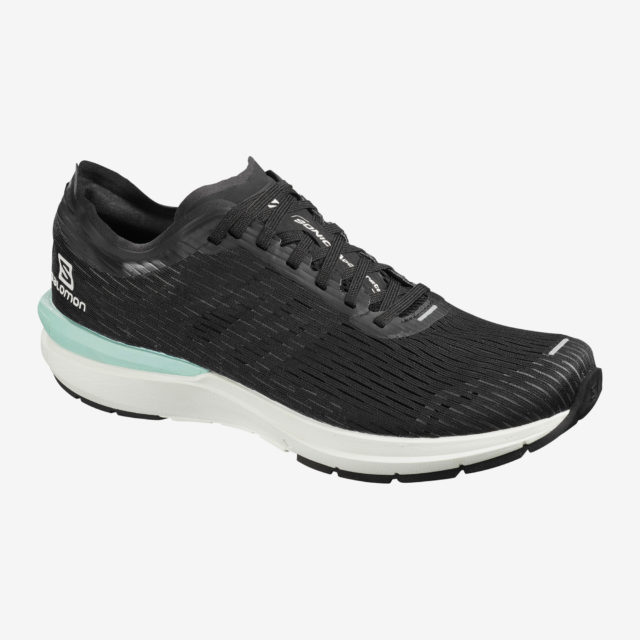
The Sonic 3 Accelerate replaces the Sonic RA Pro 2 as the lightest, most minimal shoe in the Salomon road lineup. It’s got a lower stack height and drop than the Sonic 3 Balance, while retaining the same Optivibe midsole for vibration reduction. The Sonic 3 Accelerate’s more minimal construction should make it better suited to shorter, faster runs than the Sonic 3 Balance or Confidence. Conversely, the Sonic 3 Accelerate won’t be as cushioned and protective as the other shoes in the Sonic line, so it’s probably not the best option for particularly long road runs.
Stack Height
- Heel: 24 mm
- Toe: 18 mm
Drop: 6 mm
Stated Weight
- Men's: 223 g
- Women's: 194 g
MSRP: $130.00
TRAIL SHOES
(Most Cushioned to Least Cushioned)
Spikecross 5 GTX
Most Cushion
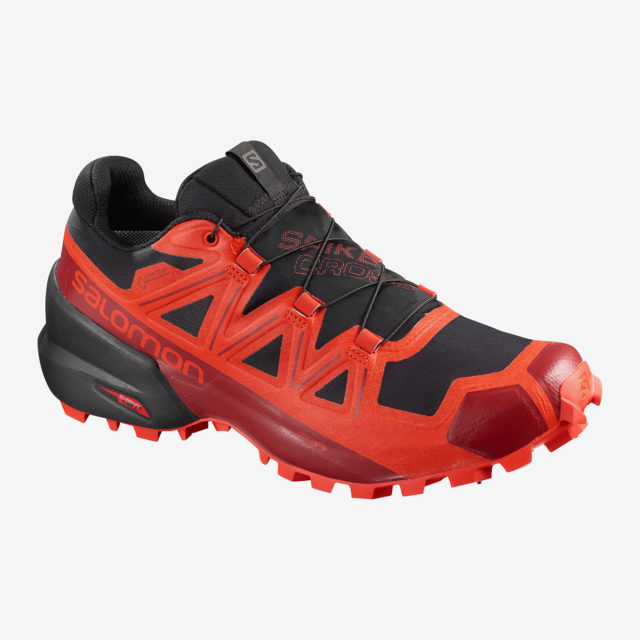
The Spikecross 5 GTX has the same fit and midsole as the Speedcross 5 (see below), but with a few additional winter-specific features for running in cold, icy / snowy conditions. Like the Speedcross 5 GTX, the Spikecross 5 GTX has a waterproof / breathable Gore-Tex upper to keep your feet dry in cold, wet weather. But the Spikecross 5 GTX adds 12 tungsten spikes in the outsole to provide extra grip on compacted snow and ice. If you like the fit and ride of the Speedcross 5 but want a shoe specifically designed for running in winter weather, the Spikecross 5 GTX could be the shoe for you.
Stack Height
- Heel: 31 mm
- Toe: 21 mm
Drop: 10 mm
Stated Weight
- Unisex: 365 g
MSRP: $185
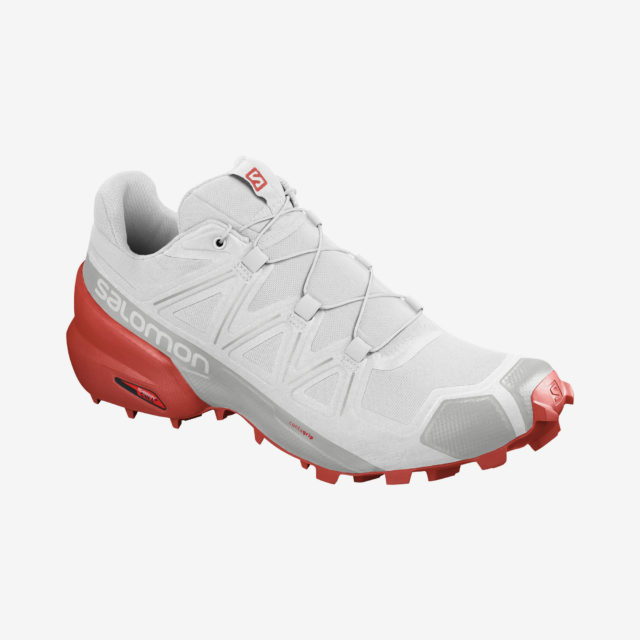
The Speedcross has been in Salomon’s line for years, and many runners love its combination of a precise, secure fit and excellent traction in wet / sloppy conditions. With large, widely spaced lugs, grippy rubber, a narrow fit, and more support than many of Salomon’s shoes, the Speedcross 5 is designed to handle harsh mountain terrain. The Speedcross 5 will thrive in wet conditions like snow and mud, making it a top choice for things like adventure races or just general trail running in wet conditions. Since the lugs are so big, this shoe won’t feel as efficient on smoother, packed trails compared to shoes with more minimal outsoles like the Ultra /Pro or Sense Ride 3. If you like the sound of the Speedcross but want more weather protection or better grip in winter conditions, you should consider checking out the Speedcross 5 GTX.
Stack Height
- Heel: 30 mm
- Toe: 20 mm
Drop: 10 mm
Stated Weight
- Men's: 320 g
- Women's: 280 g
MSRP: $130.00
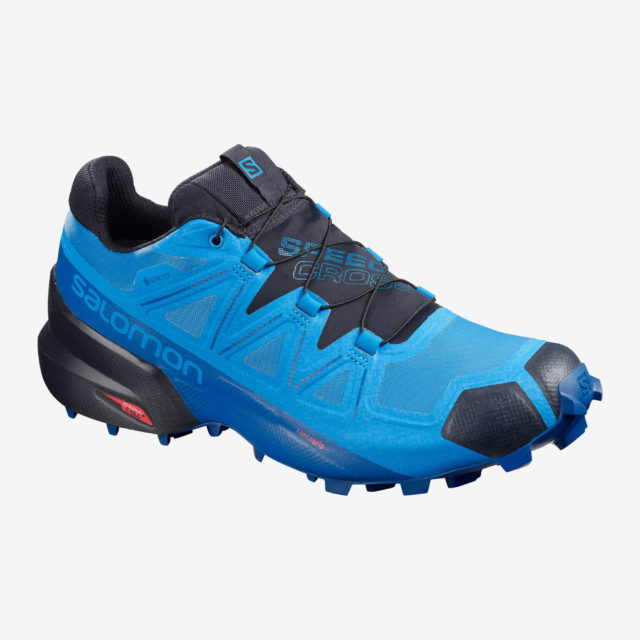
This is the same as the Speedcross 5 GTX Nocturne from last year, but lacks the 360° reflectivity of that previous shoe. But if you like the Speedcross 5 and are looking for a shoe to use in wet / cold weather, the GTX version is the shoe for you.
Stack Height
- Heel: 30.9 mm
- Toe: 20.9 mm
Drop: 10 mm
Stated Weight
- Men's: 340 g
- Women's: 290 g
MSRP: $160.00
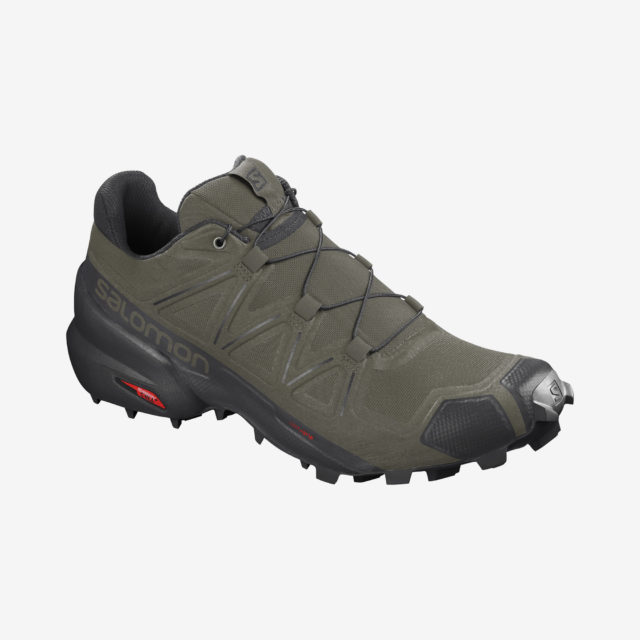
Because some individuals’ feet don’t work well with Salomon’s generally narrower fit, the brand now sells several of their best sellers in Wide versions. The Speedcross 5 Wide is one of those shoes, and Salomon claims that the circumference of the forefoot of the Wide version is 12 mm larger. If you struggle with the Speedcross 5 feeling far too narrow, this may be a good shoe to try. That said, we still wouldn’t call this a particularly wide or high-volume shoe, compared to the whole market. So, as always, we highly recommend trying on shoes at your local shop before buying.
Stack Height
- Heel: 30 mm
- Toe: 20 mm
Drop: 10 mm
Stated Weight
- Men's: 320 g
- Women's: 280 g
MSRP: $130.00
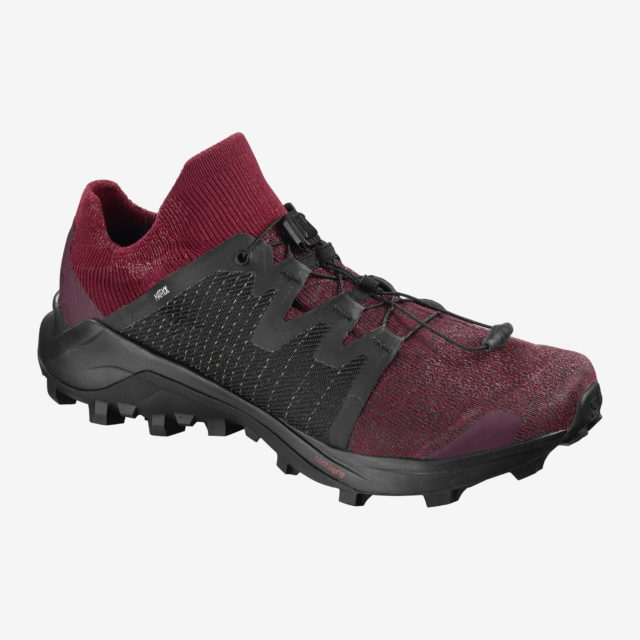
The Cross /Pro brings elements of Salomon’s custom-build shoe, the ME:SH, to their standard trail shoe lineup. It’s got a water-repellant, woven MATRYX fabric reinforcement for stability that’s combined with Salomon’s new “MULTI-FIT” technology, which is a sock-like, knit upper designed to adapt the shoe’s fit to your foot shape as you tighten the laces. The Cross /Pro also has an aggressive, sticky rubber outsole with deep lugs to maximize grip in wet / soft conditions. The molded EVA midsole is fairly thin and firm, so the Cross /Pro is definitely best suited to shorter runs on technical, soft terrain. The Cross /Pro could be thought of as a lighter, more race-oriented version of the SpeedCross 5 with a more customizable fit — so if you like the SpeedCross but want something a little lighter for race day and / or with a more forgiving fit, the Cross /Pro might fit the bill.
Stack Height
- Heel: 29.5 mm
- Toe: 21.5 mm
Drop: 8 mm
Stated Weight
- Men's: 290 g
- Women's: 250 g
MSRP: $160.00
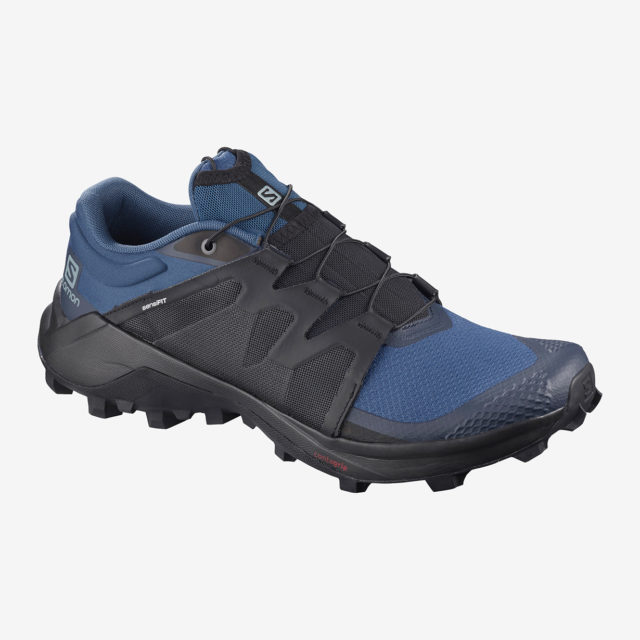
The Wildcross is designed to provide even more support and grip on muddy terrain than the Speedcross 5. It has large, multi-directional lugs that should provide more traction in especially slippery conditions than the Speedcross 5. The Wildcross also has a slightly lower drop than the Speedcross 5. When combined with the Wildcross’s more structured, supportive upper, its lower drop should make it more stable and secure than the Speedcross 5 on uneven terrain. The Wildcross has a fairly similar construction to the Cross /Pro, but with a more standard mesh upper with substantial midfoot reinforcements, in place of the sock-like knit and MATRYX upper found on the Cross /Pro. The Wildcross is also a little more affordable than the more race-oriented Cross /Pro, so it might be a better option for everyday training runs in muddy conditions.
Stack Height
- Heel: 29.5 mm
- Toe: 21.5 mm
Drop: 8 mm
Stated Weight
- Men's: 290 g
MSRP: $130.00
Salomon Wildcross GTX
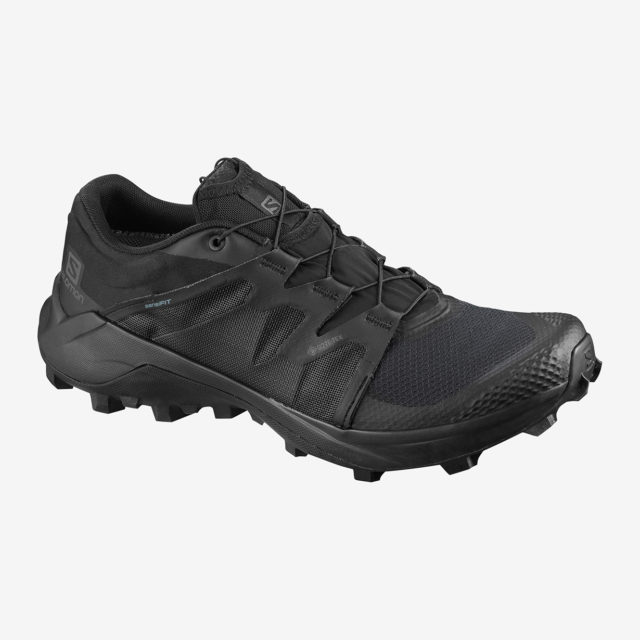
The Wildcross GTX takes the same aggressive outsole, secure fit, and moderate drop of the Wildcross and adds some extra weather protection with a waterproof / breathable Gore-Tex upper. If you like the fit and ride of the Wildcross but usually run in wet, cold weather, this shoe could be a good option.
Stack Height
- Heel: 29.5 mm
- Toe: 21.5 mm
Drop: 8 mm
Stated Weight
- Men's: 290 g
MSRP: $160.00
Salomon Supercross Blast
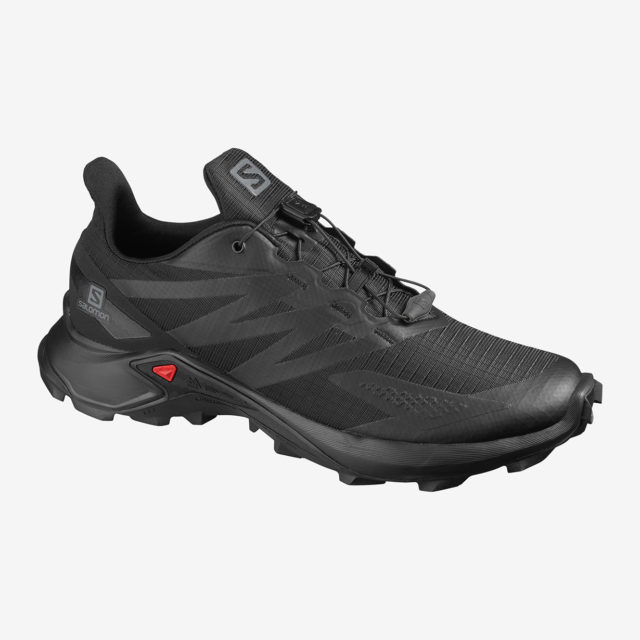
The Supercross Blast looks a lot like the Speedcross it replaces, but with a few notable tweaks. They both have aggressive, soft-terrain-oriented outsole patterns, but the Supercross Blast uses a slightly more durable and less grippy rubber compound. The Supercross Blast also uses a slightly less structured and supportive upper, and a midsole with a bit less rebound and cushioning. Lastly, it’s a bit lighter and less expensive than the Speedcross 5, and is a solid choice for people seeking a trail shoe that excels in challenging conditions like mud and loose dirt. And if you want a slightly lighter and cheaper ($90) alternative, the more all-purpose Salomon Alphacross Blast is worth a look.
Stack Height
- Heel: 29.3 mm
- Toe: 19.3 mm
Drop: 10 mm
Stated Weight
- Men's: 315 g
- Women's: 260 g
MSRP: $110.00
Salomon Supercross Blast GTX
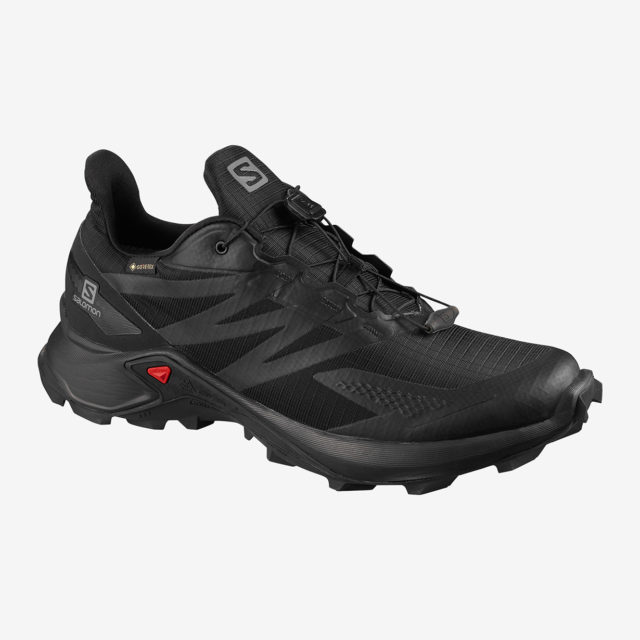
This is the same shoe as the Supercross Blast, but with a Gore-Tex insert to keep out water, at the cost of breathability.
Stack Height
- Heel: 29.9 mm
- Toe: 19.9 mm
Drop: 10 mm
Stated Weight
- Men's: 340 g
- Women's: 290 g
MSRP: $130.00
Salomon Alphacross Blast
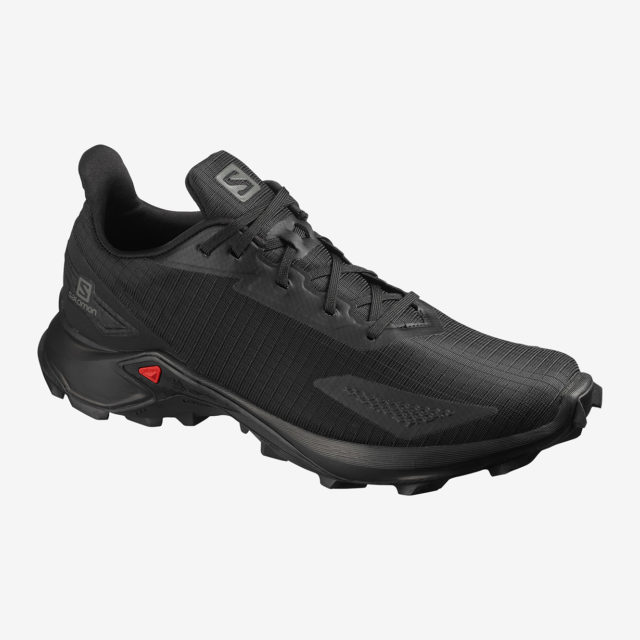
The Alphacross Blast repackages some of the features of the Speedcross 5 into a more affordable, versatile everyday training shoe. It’s got a pretty aggressive outsole with chevron-shaped lugs designed for muddy / soft terrain, a woven ripstop upper, and a softer EnergyCell midsole. The outsole and midsole are essentially the same as the Supercross Blast, but the Alphacross Blast has a slightly more minimal, less structured upper and traditional laces. This makes it both lighter and cheaper than the Supercross, but it likely won’t feel quite as secure on more technical terrain and might not last quite as long. If you’re looking for a reasonably priced, comfortable shoe that’s still got decent traction and protection for moderate terrain, the Alphacross Blast is worth checking out.
Stack Height
- Heel: 29 mm
- Toe: 19 mm
Drop: 10 mm
Stated Weight
- Men's: 300 g
- Women's: 265 g
MSRP: $90.00
Salomon Alphacross Blast GTX
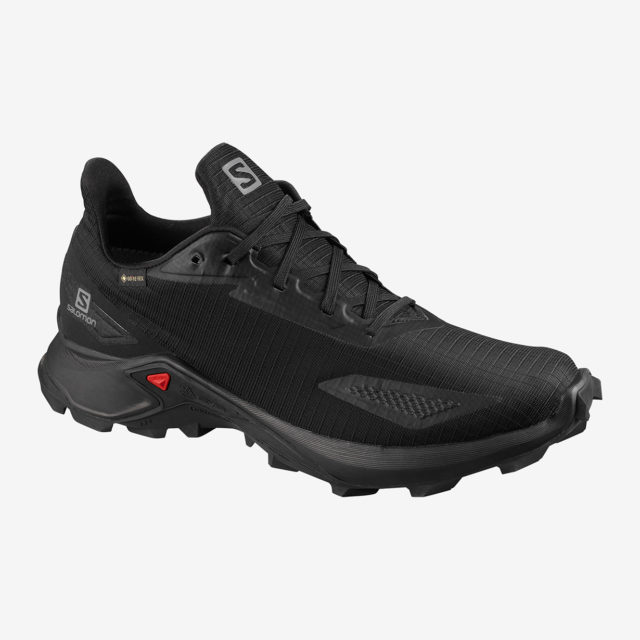
The Alphacross Blast GTX has the same features and construction as the Alphacross Blast, but with an added GoreTex membrane to keep your feet dry in wet / cold conditions. If you like the looks of the Alphacross but usually run in wet weather, the Alphacross GTX could be a solid option.
Stack Height
- Heel: 29 mm
- Toe: 19 mm
Drop: 10 mm
Stated Weight
- Men's: 340 g
- Women's: 275 g
MSRP: $110.00
Salomon S/Lab Ultra 3
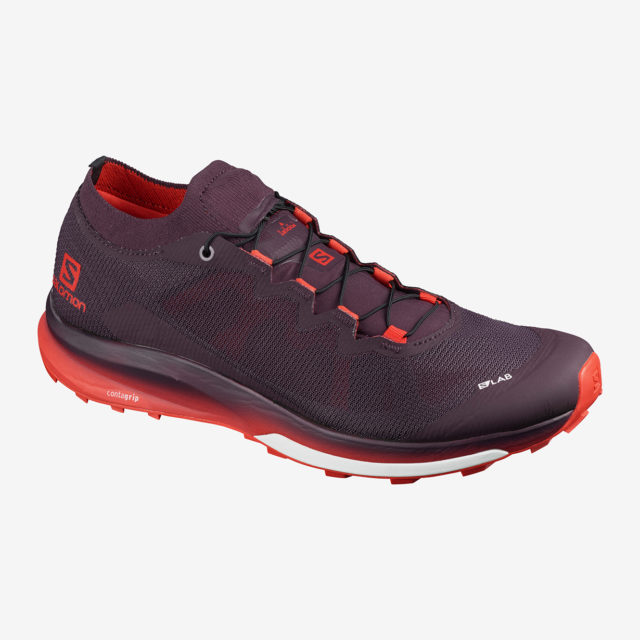
The S/Lab Ultra 3 is Salomon’s most cushioned race-specific trail shoe. It’s designed to provide a comfortable, yet fast ride for long-distance trail races on all kinds of terrain. The third version of the S/Lab Ultra has the same fairly firm / energetic midsole as the previous version, but with a redesigned mesh upper that should improve the shoe’s breathability. While the S/Lab Ultra 3 is fairly similar to the Ultra /Pro, the S/Lab Ultra 3 has a less structured upper, a slightly thicker midsole, and a notably narrower / lower-volume fit. It’s also a few grams lighter than the Ultra /Pro, but it’s worth remembering that the S/Lab Ultra 3 is designed to be race-specific — so it might not hold up to everyday use as well as the Ultra /Pro. For more on the previous S/Lab Ultra 2, check out our full review.
Stack Height
- Heel: 28 mm
- Toe: 20 mm
Drop: 8 mm
Stated Weight
- Unisex: 290 g
MSRP: $180.00
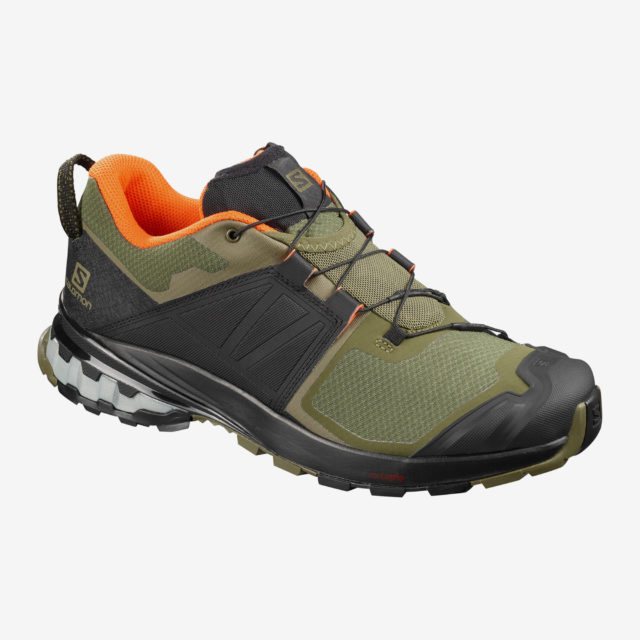
The XA Wild is built on a similarly supportive, all-terrain platform to the popular XA Pro 3D V8. It’s got a rigid plastic “chassis” sandwiched between the midsole and the outsole, which is designed to limit overpronation and protect your feet on technical trails. With its stiff midsole, durable upper, and heavier weight, the XA Wild is more of a cross between a hiking shoe and a trail runner (and for most people, we think it’ll work best as a hiking shoe, just like the XA Pro 3D). It definitely won’t feel as smooth and light on-trail as a more flexible shoe like the Sense Ride 3 or Ultra /Pro — but if you’re looking for an extremely durable, extremely supportive, and extremely protective shoe for running and hiking both on and off trail, the XA Wild could be a good option.
Stack Height
- Heel: 28 mm
- Toe: 17 mm
Drop: 11 mm
Stated Weight
- Men's: 355 g
- Women's: 300 g
MSRP: $130.00
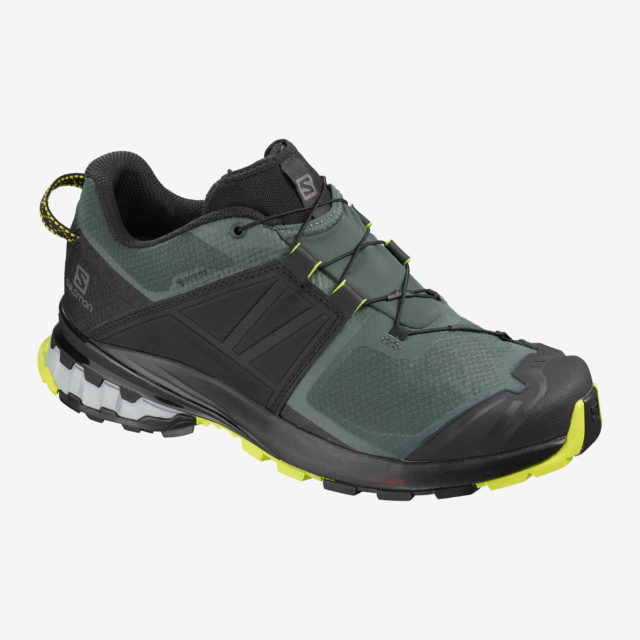
If you like the looks of the XA Wild but want a little more weather protection, check out the XA Wild GTX. It’s got the same features for providing stability and support on technical terrain, but with a waterproof / breathable GoreTex membrane for extra protection in cold, wet conditions.
Stack Height
- Heel: 28 mm
- Toe: 17 mm
Drop: 11 mm
Stated Weight
- Men's: 375 g
- Women's: 325 g
MSRP: $150.00
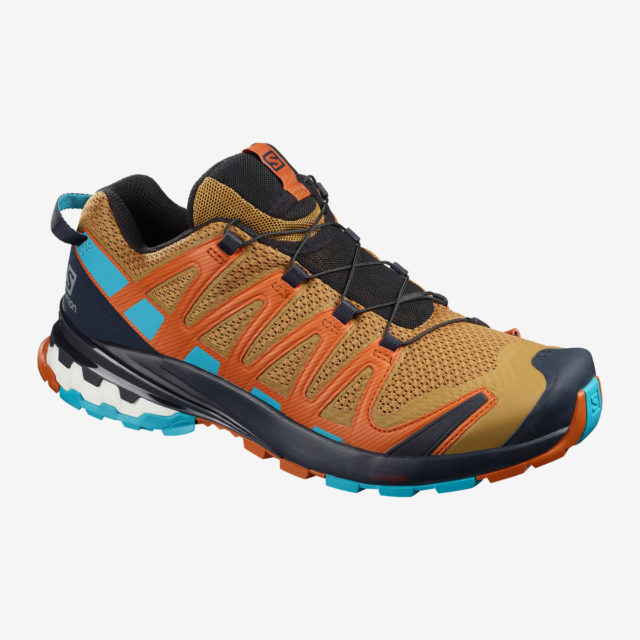
Now in it’s 8th version, the XA Pro 3D has been a staple in Salomon’s trail running / hiking lineup for quite a while. It’s designed more as a hybrid running / hiking shoe for technical terrain than the brand’s more running-specific models like the Sense Ride 3 or Ultra /Pro. Much like the XA Wild, the XA Pro 3D V8 has a rigid plastic “3D Chassis” in the midsole to provide extra support on rough terrain. While it’s still not a lightweight shoe, the XA Pro 3D V8 is about 20 g lighter than the previous version of the shoe. It’s also a bit lighter than the XA Wild and has a slightly more breathable upper than the XA Wild — so if your run / hikes tend to be more running than hiking, the XA Pro 3D V8 might be a slightly better option than the XA Wild. That said, we still view both of these XA shoes as more hiking oriented than many of Salomon’s other options.
Stack Height
- Heel: 28 mm
- Toe: 17 mm
Drop: 11 mm
Stated Weight
- Men's: 340 g
- Women's: 300 g
MSRP: $130.00
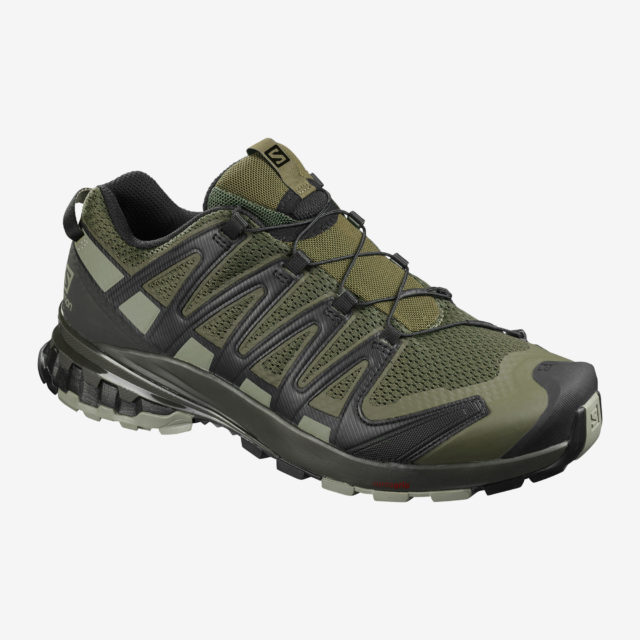
If you like the looks of the XA Pro 3D V8 but usually find that Salomon’s shoes are too narrow for your feet, you’re in luck — the XA Pro 3D V8 Wide has all the same features as the XA Pro 3D V8, but it’s built on a wider last to accommodate runners with wider / higher-volume feet.
Stack Height
- Heel: 28 mm
- Toe: 17 mm
Drop: 11 mm
Stated Weight
- Men's: 350 g
MSRP: $130.00
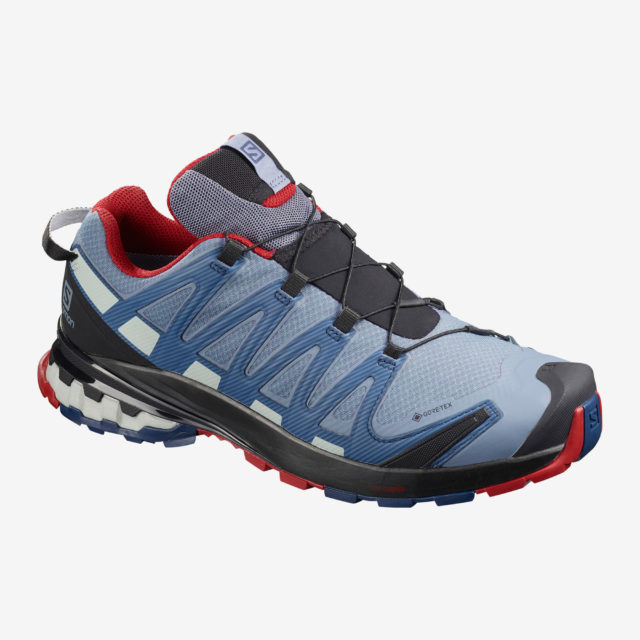
The addition of a waterproof / breathable GoreTex membrane makes the XA Pro 3D V8 GTX a solid option for people looking for a running and light hiking shoe for wet, cold conditions.
Stack Height
- Heel: 28 mm
- Toe: 17 mm
Drop: 11 mm
Stated Weight
- Men's: 370 g
- Women's: 315 g
MSRP: $150.00
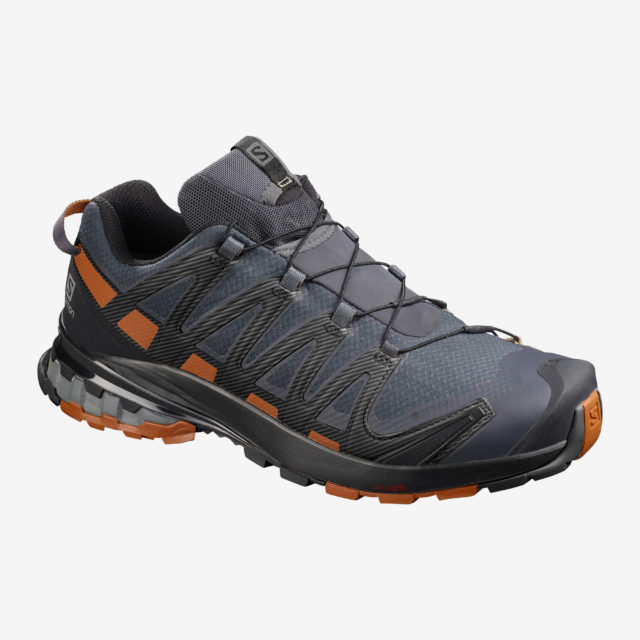
Like the XA Pro 3D V8, the XA Pro 3D V8 GTX is also available with a wider fit for runners with wide / high-volume feet who want some extra weather protection.
Stack Height
- Heel: 28 mm
- Toe: 17 mm
Drop: 11 mm
Stated Weight
- Men's: 375 g
MSRP: $150.00
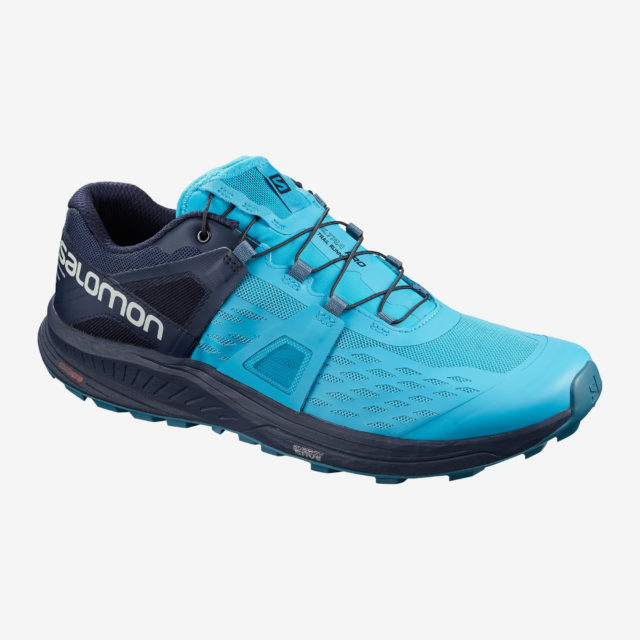
If you enjoy the general ride of the S/Lab Ultra 2 but want something that’ll hold up better to regular training days, this is a good shoe to have on hand. It’s got similar amounts of cushioning and protection to the S/Lab Ultra 2 but with a wider / higher-volume fit. Alternatively, if you like the sound of the Sense Ride 2 but want something with a more supportive upper and firmer midsole cushioning, the Ultra /Pro might be the shoe for you. It’s worth noting that we found the Ultra /Pro to fit quite differently vs. most Salomon shoes, so we definitely encourage people to try this shoe on before buying, and potentially try it a half-size or full-size smaller than the size they prefer in other Salomon shoes. (Check out our full review of the Ultra /Pro)
Stack Height
- Heel: 27 mm (men); 23 mm (women)
- Toe: 19 mm (men); 15 mm (women)
Drop: 8 mm
Stated Weight
- Men's: 300 g
- Women's: 260 g
MSRP: $150.00
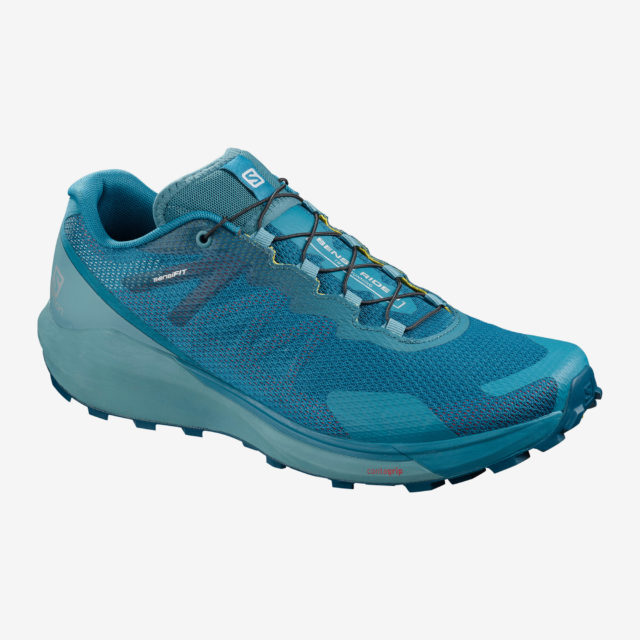
The Sense Ride 3 used a version of the Optivibe midsole technology found in Salomon’s new road shoes to provide a slightly softer ride than the previous version of the shoe. Salomon claims that their Optivibe midsole foam reduces impact vibrations in order to reduce muscle fatigue, especially for heel-strikers. Aside from that, the Sense Ride 3 has a similar fit and upper construction to the Sense Ride 2. It’s more cushioned than the Sense 4 /Pro and offers a softer, more flexible ride than the Ultra /Pro. If you’re looking for a moderately cushioned shoe for longer days on moderate or non-technical terrain, the Sense Ride 3 could be a solid option.
Stack Height
- Heel: 27 mm
- Toe: 19 mm
Drop: 8 mm
Stated Weight
- Men's: 280 g
- Women's: 235 g
MSRP: $120.00
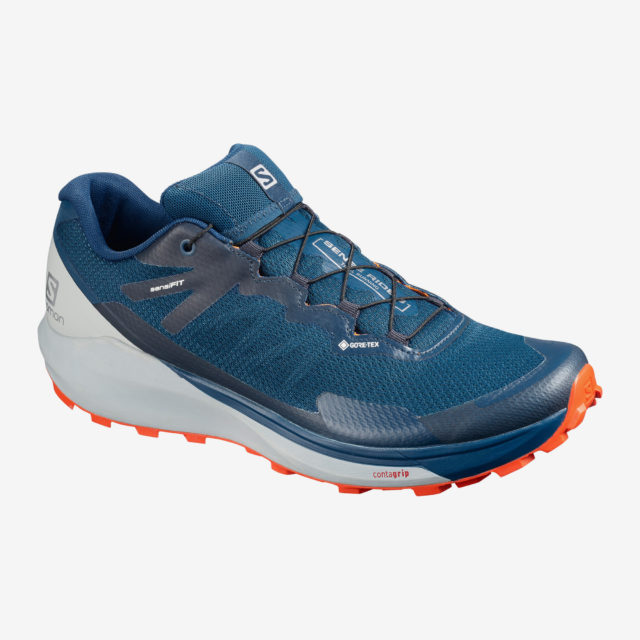
This is the waterproof version of the Sense Ride, featuring the same midsole and outsole but with a GoreTex layer in the upper. This makes it better for cold and / or wet runs, but that comes at the cost of reduced breathability. GoreTex’s “Invisible Fit” tech integrates the waterproof layer into the outer part of the upper rather than using a traditional internal liner, which should make the waterproof version fit and feel much more similarly to the standard Sense Ride 3 vs. a traditional liner or “bootie” waterproof construction.
Stack Height
- Heel: 27 mm
- Toe: 19 mm
Drop: 8 mm
Stated Weight
- Men's: 290 g
- Women's: 250 g
MSRP: $160.00
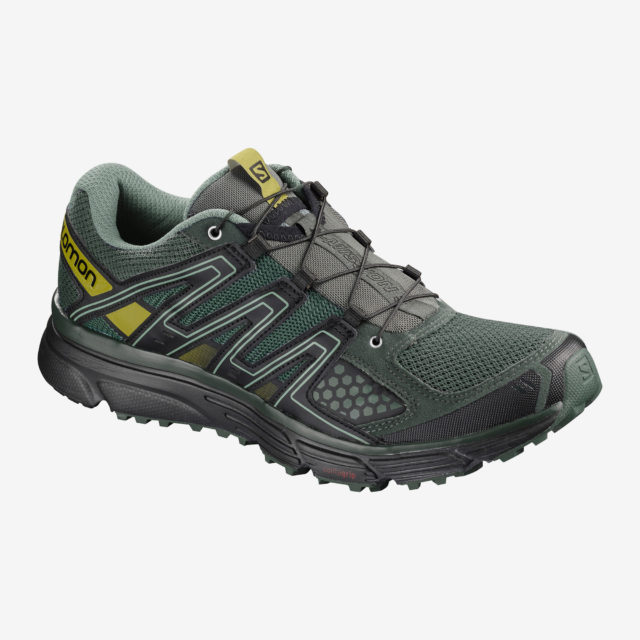
Like the Trailster, the X-Mission 3 is designed to seamlessly transition between pavement and trails, and is a good alternative to the Trailster if you want a shoe with a more structured, supportive upper and / or a bit less cushioning. The X-Mission 3 has a higher arch and a wider toe box, and the inlays in the upper help to hold your foot in place and prevent movement to accommodate for the additional room in the toe box.
Stack Height
- Heel: 26.5 mm
- Toe: 16.5 mm
Drop: 10 mm
Stated Weight
- Men's: 300 g
- Women's: 250 g
MSRP: $115.00
Salomon XA Collider
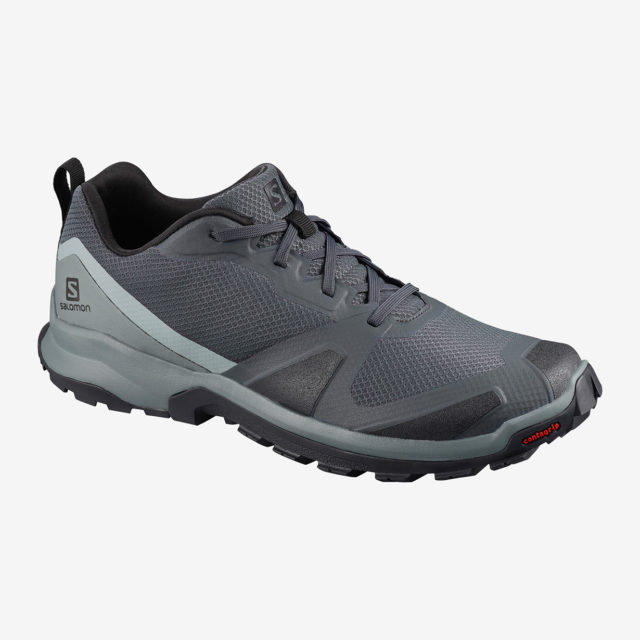
The new XA Collider is the lightest and least supportive of Salomon’s XA series shoes, all of which are designed for a mix of running and hiking. It’s got a fairly firm EVA midsole but lacks the hard, plastic “3D Chassis” found in the XA Wild and XA Pro 3D V8. So while the XA Collider won’t provide quite as much support and protection on technical terrain as the XA Wild or XA Pro 3D V8, it should be a bit more flexible and comfortable on moderate terrain, potentially making it better for running and / or shorter hikes. If you’re looking for a shoe that can handle both running and hiking but don’t usually spend too much time on more technical terrain, the XA Collider could be a solid option.
Stack Height
- Heel: 25 mm
- Toe: 15 mm
Drop: 10 mm
Stated Weight
- Men's: 295 g
- Women's: 255 g
MSRP: $90.00
Salomon XA Collider GTX
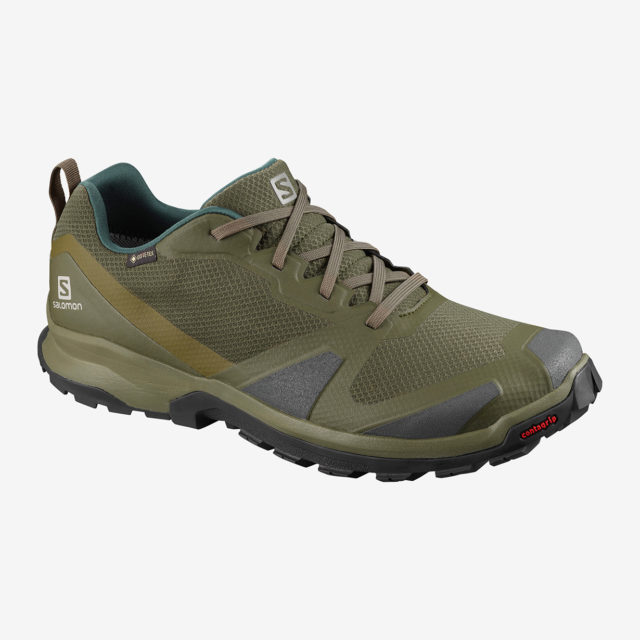
If you like the sound of the XA Collider but usually run / hike in wet, cold conditions, the XA Collider GTX could be the shoe for you. It’s got the same fit, midsole, and outsole as the XA Collider, but with a waterproof / breathable upper for added weather protection.
Stack Height
- Heel: 25 mm
- Toe: 15 mm
Drop: 10 mm
Stated Weight
- Men's: 320 g
- Women's: 275 g
MSRP: $110.00
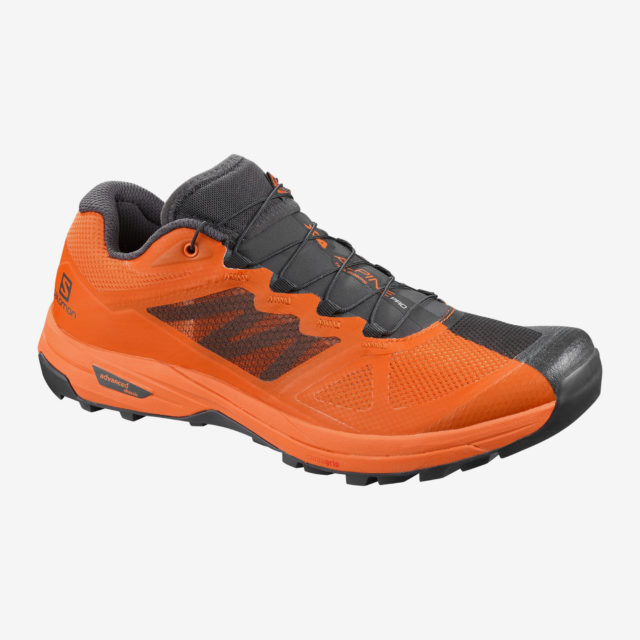
If you prefer adventures above treeline, this shoe may be a good match. As part of Salomon’s “Alpine” line, the X Alpine Pro blends features of running shoes with those of climbing approach shoes. Its outsole is designed to excel on rock and features a flat “climbing zone” near the toe for maximum grip when scrambling. Its thin upper should be very durable and its added overlays offer more protection than many of Salomon’s general trail running shoes like the Sense Pro 3. Lastly, the X Alpine Pro uses a more supportive chassis that’s designed to make the shoe feel stable when running / scrambling on inconsistent, rocky terrain, which may also make it feel a bit rigid and not super smooth while running on mellower terrain.
Stack Height
- Heel: 24.3 mm
- Toe: 18.3 mm
Drop: 6 mm
Stated Weight
- Men's: 310 g
- Women's: 270 g
MSRP: $160.00
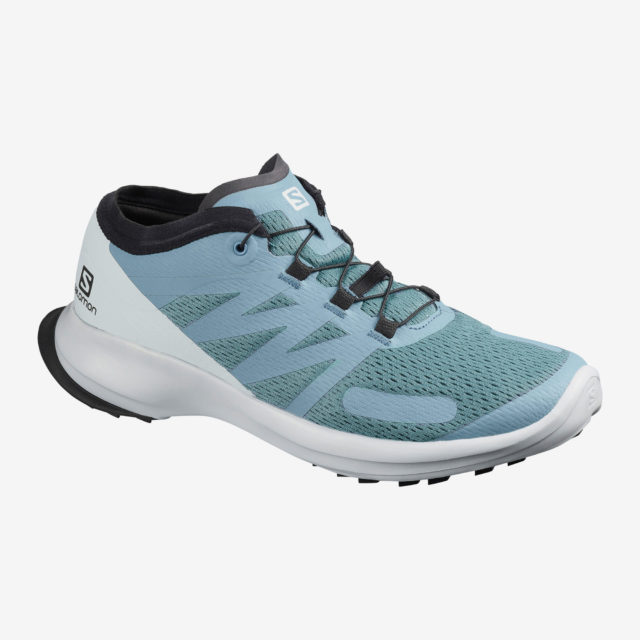
The Sense Flow is one of two new additions to Salomon’s Sense series for 202 geared towards “road-to-trail” use. It’s got fairly low-profile outsole lugs that should provide just enough traction on moderate trails without getting in the way on roads, and a fairly firm EnergyCell midsole. The Sense Flow should be a solid option for runners looking for a relatively affordable, multi-use shoe for running a mix of non-technical trails and roads. If you’re going to be on more gnarly, technical trails you’d likely be better off with a shoe like the Speedcross 5. The Sense Flow is slightly heavier than the Sense Feel, Salomon’s other new road-to-trail shoe. If you prioritize a bit of extra cushion / protection over light weight, the Sense Flow will likely be a better option than the Sense Feel.
Stack Height
- Heel: 24 mm
- Toe: 16 mm
Drop: 8 mm
Stated Weight
- Men's: 257 g
- Women's: 224 g
MSRP: $110.00
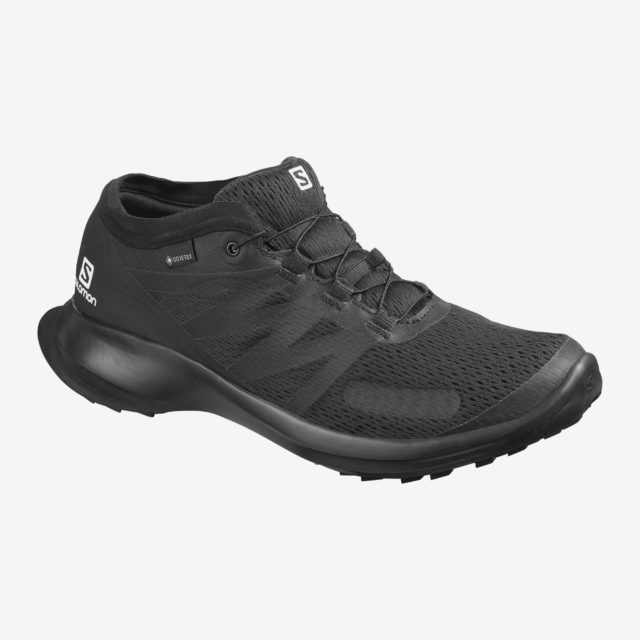
The Sense Flow GTX has all the same features as the Sense Flow, but with a waterproof / breathable GoreTex upper. If you usually run a mix of roads and moderate trails in wet, cold conditions, the Sense Flow GTX might be worth a closer look.
Stack Height
- Heel: 24 mm
- Toe: 16 mm
Drop: 8 mm
Stated Weight
- Men's: 283 g
- Women's: 242 g
MSRP: $130.00
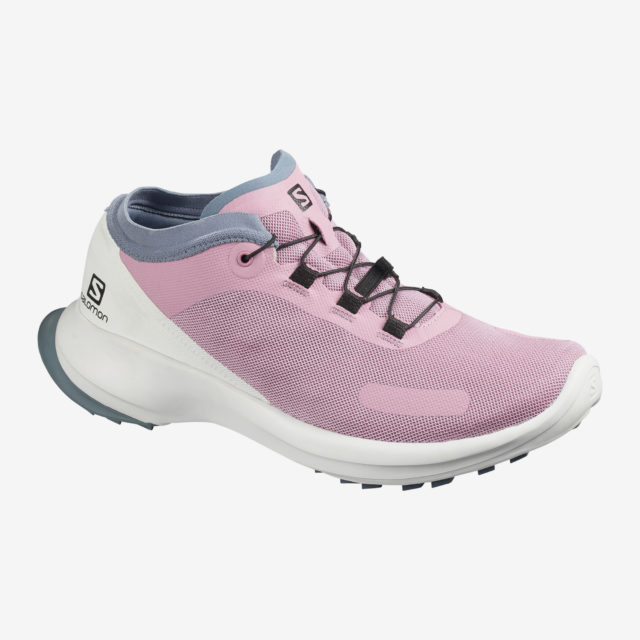
The Sense Feel is slightly lighter, has a less structured upper, and is likely more breathable compared to the Sense Flow — but its intended purpose is pretty much the same. The Sense Feel’s low-profile outsole lugs, fairly firm cushioning, and “sock-like” fit are designed for a mix of roads and non-technical trails. If your runs typically consist of that kind of terrain and you prefer a lighter shoe over one that provides more support, structure, and protection through the upper, the Sense Feel may be a good option.
Stack Height
- Heel: 24 mm
- Toe: 16 mm
Drop: 8 mm
Stated Weight
- Men's: 247 g
- Women's: 213 g
MSRP: $80.00
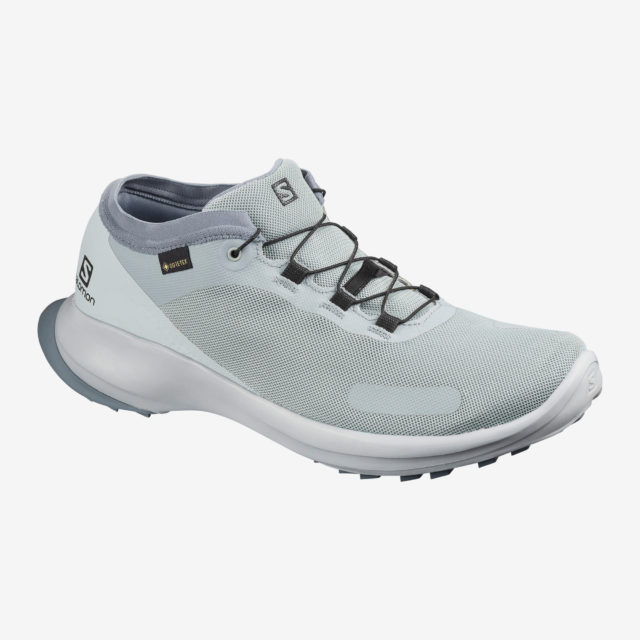
With the addition of a waterproof / breathable GoreTex upper, the Sense Feel GTX is designed for running a mix of roads and trails in cold, wet conditions. If that sounds similar to what you usually do, the Sense Feel GTX could be a good fit.
Stack Height
- Heel: 24 mm
- Toe: 16 mm
Drop: 8 mm
Stated Weight
- Men's: 273 g
- Women's: 235 g
MSRP: $100.00
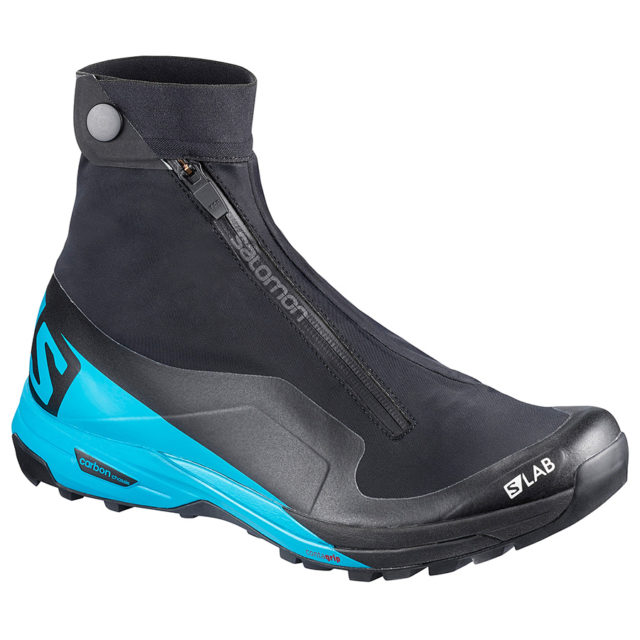
Like the S/Lab X Alpine Modular, the S/Lab XA Alpine 2 is a hybrid running / mountaineering shoe, though it’s a standard, “single shoe” and not a modular one. The midsole geometry is based on the design of the S/Lab Sense 8, but the S/Lab XA Alpine 2 has a stiff, carbon-fiber “edging chassis,” which makes it much stiffer than a traditional running shoe. This should make the shoe feel much more secure for scrambling / climbing, but it won’t have nearly as smooth of a ride when running on normal trails. The carbon chassis also makes the S/Lab XA Alpine 2 compatible with some crampons for more serious mountaineering. While the S/Lab XA Alpine 2 does have an integrated ankle-height gaiter, it’s not fully waterproof — the gaiter is mostly intended to keep rocks and snow out of the shoe rather than keep your feet completely dry. If your mountaineering routes often have especially long, runnable approaches, the S/Lab X Alpine Modular might be a better option, as it gives you the ability to wear a true running shoe on non-technical sections. But if you’re looking for a shoe to tackle routes that mix scrambling, climbing, snow / ice, and some trail running, the S/Lab XA Alpine 2 could be a worthwhile investment.
Stack Height
- Heel: 22 mm
- Toe: 16 mm
Drop: 6 mm
Stated Weight
- Unisex: 370 g
MSRP: $250.00
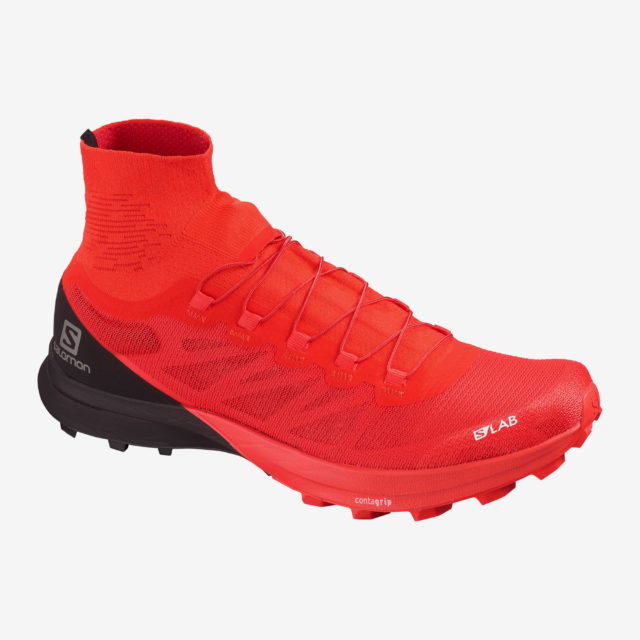
The S/Lab Sense 8 SG is designed for racing and running fast on soft, loose terrain. It’s got the same midsole geometry and fit as the S/Lab Sense 8, but with much larger, more widely spaced lugs and a stickier rubber compound for extra grip on muddy terrain. The S/Lab Sense 8 SG also has an integrated ankle height sock-like gaiter to keep debris out of the shoe. The S/Lab Sense 8 SG features a new knit upper and slightly softer cushioning relative to the S/Lab Sense 7 SG. It’s also a few grams lighter. As with most S/Lab shoes, the Sense 8 SG is intended for racing use only, so it likely won’t hold up quite as long as a shoe like the Speedcross 5. But if you’re looking for an extremely light, minimal race-day shoe for soft conditions, the S/Lab Sense 8 SG is a solid option.
Stack Height
- Heel: 22 mm
- Toe: 18 mm
Drop: 4 mm
Stated Weight
- Unisex: 205 g
MSRP: $180.00
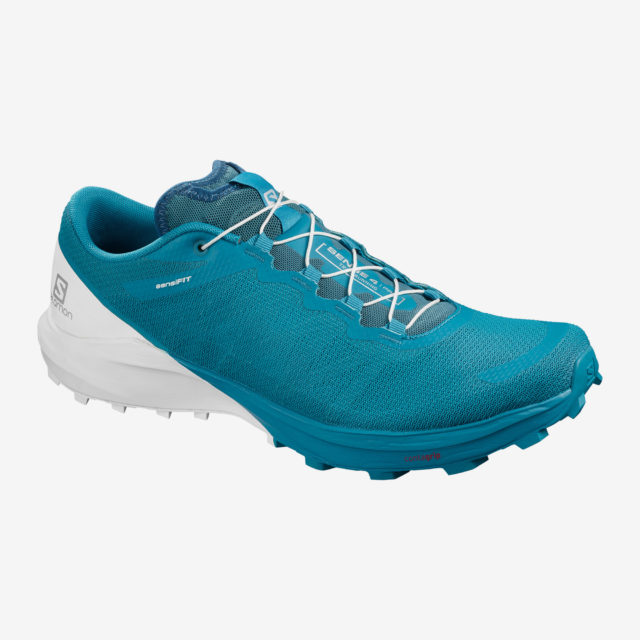
The Sense 4 /Pro has a new single-layer mesh upper and thicker Optivibe midsole, but has the same intended purpose as the previous version of the shoe, the Sense Pro 3. The Sense 4 /Pro is less cushioned than the Sense Ride 3, but significantly more protective / cushioned than the S/Lab Sense 8. Like the Sense Ride 4, the Sense 4 /Pro uses the Optivibe midsole material found in Salomon’s newer road shoes to provide a slightly softer ride than the Sense Pro 3. If you’re looking for a low-drop, fairly low cushion shoe for both everyday training and shorter races, the Sense 4 /Pro could be worth a look. (Check out our full review of the Sense 4 /Pro)
Stack Height
- Heel: 21 mm
- Toe: 17 mm
Drop: 4 mm
Stated Weight
- Men's: 272 g
- Women's: 215 g
MSRP: $140.00
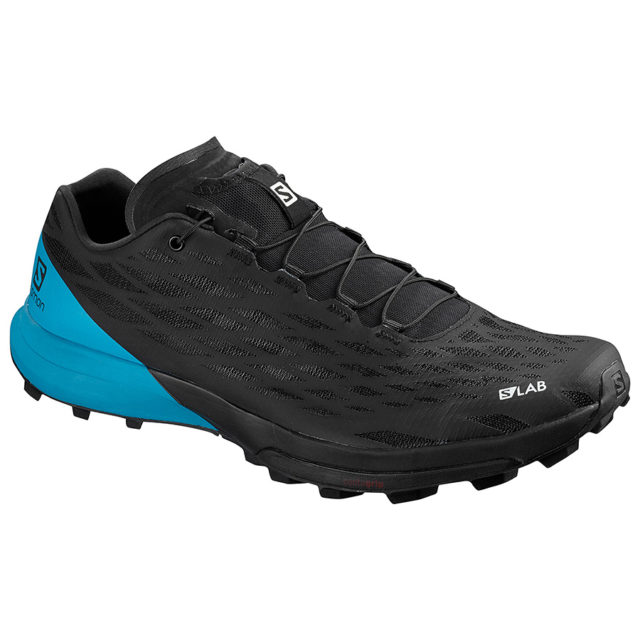
This is another fairly niche shoe, designed specifically for runs that involve a lot of water, whether that be river crossings, rain, or races that involve both running and swimming. Rather than using a waterproof insert to keep water out, the S/Lab XA Amphib 2 uses a very breathable, open-knit upper designed to let water quickly move in and out of the shoe. It also features a ContaGrip outsole with a rubber compound specifically designed for wet terrain, though the lugs aren’t quite as aggressive as the S/Lab Speed 2 — so the S/Lab Speed 2 still probably has an edge in especially sloppy, deep mud or snow. The S/Lab XA Amphib 2 is also very light with a firm, energetic midsole, protective film insert, and fairly minimal cushioning.
Stack Height
- Heel: 20 mm
- Toe: 16 mm
Drop: 4 mm
Stated Weight
- Unisex: 215 g
MSRP: $180.00
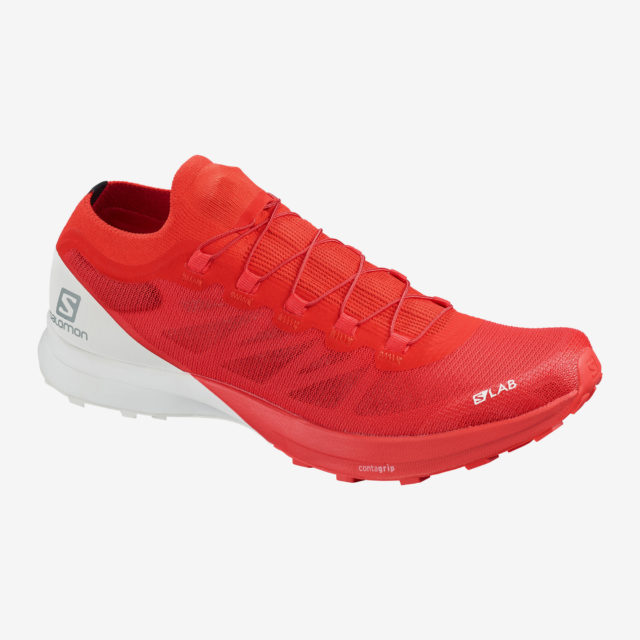
This is Salomon’s lightest and most minimal firm-ground trail shoe. S/Lab Sense 8 has a new, knit, “sock-like” upper that’s even thinner and more minimal than the S/Lab Sense 7, which also makes the Sense 8 even lighter than before. Aside from the new upper, the S/Lab Sense 8 uses a slightly softer midsole foam to provide a bit of extra cushion. Like previous versions of the shoe, the S/Lab Sense 8 has a thin forefoot rock plate to provide some protection from sharp rocks / roots. It’s also got a fairly low-profile Contagrip MA outsole that’s designed to provide traction on moderate terrain without getting in the way of efficiency when running fast. If you usually run on more technical / loose terrain, the S/Lab Sense 8 SG will provide much more grip while maintaining the minimal, fast ride of the S/Lab Sense 8. The S/Lab Sense 8’s low drop, low stack height, and firm cushioning mean that it won’t be a great option for longer runs for many people. But if you’re looking for an extremely light / fast shoe for shorter races, the S/Lab Sense 8 could be pretty hard to beat. (Check out our full review of the S/Lab Sense 8)
Stack Height
- Heel: 20 mm
- Toe: 16 mm
Drop: 4 mm
Stated Weight
- Unisex: 195 g
MSRP: $180.00
Salomon S/Lab Cross (unisex)
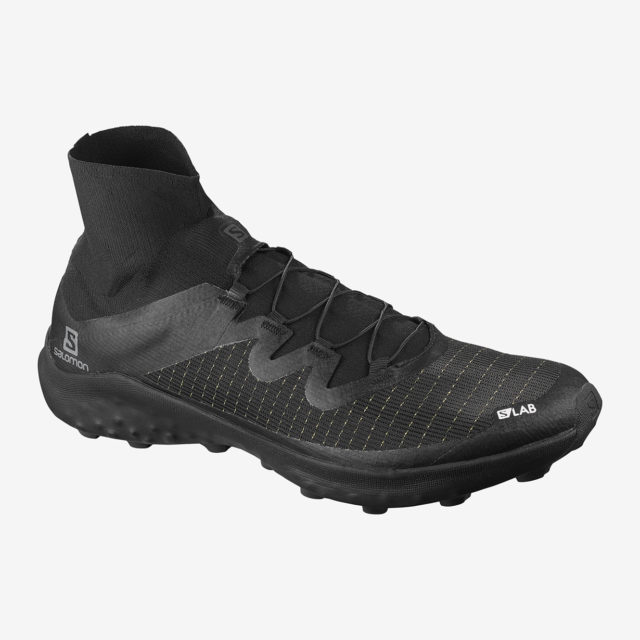
The new S/Lab Cross is a race-specific shoe designed for even muddier, more technical terrain than the S/Lab Sense 8 SG, and with an even thinner, more minimal midsole. It replaces the S/Lab Speed 2 as Salomon’s mud-specific racing shoe. Like the S/Lab Sense 8 SG, it has a narrow fit and an integrated sock-like, ankle-height gaiter to keep debris out of the shoe. But the S/Lab Cross’s midfoot and forefoot use the fairly rigid MATRYX upper material found on the Cross /Pro, which should provide a slightly more locked-down fit than the S/Lab Sense 8 on technical / off camber terrain. The S/Lab Cross also has an extremely aggressive outsole, with deep, widely spaced, multi-directional lugs that should provide even more traction in mud than the S/Lab Sense 8 SG. If you’re looking for a lightweight shoe for racing in extremely muddy, technical terrain, the S/Lab Cross is worth a closer look.
Stack Height
- Heel: 13 mm
- Toe: 9 mm
Drop: 4 mm
Stated Weight
- Unisex: 230 g

Great line up review.
(too many shoes to choose from)
Thank you for this, this is great.
I love the Sense 4 Pro!
But, what is a similar shoe that can also stay dry during the winter?
Hey Andrew-
I’d check out the Arc’Teryx Norvan SL GTX, La Sportiva Kaptiva GTX, or Salomon Sense Ride 3 GTX — none of them are exactly the same as the Sense 4 /Pro, but those are the shoes that will probably feel most similar to the Sense 4 /Pro while offering some additional weather protection. Hope that helps!
Many thanks. I am a bit of a gear junky, but it’s still hard to keep track of what’s out there! Thx again.
i want to add that every salomon shoe dries and drains extremely quickly. ive had to run through knee high creeks, pooring rain, snow….ive never had a problem with them feeling wet for long. It’s pretty impressive.
I agree with Marilyn, In NZ there is less need for GTX protection on most trails even in winter so whilst you expect to get wet and muddy they drain very well and you feet dont overheat.